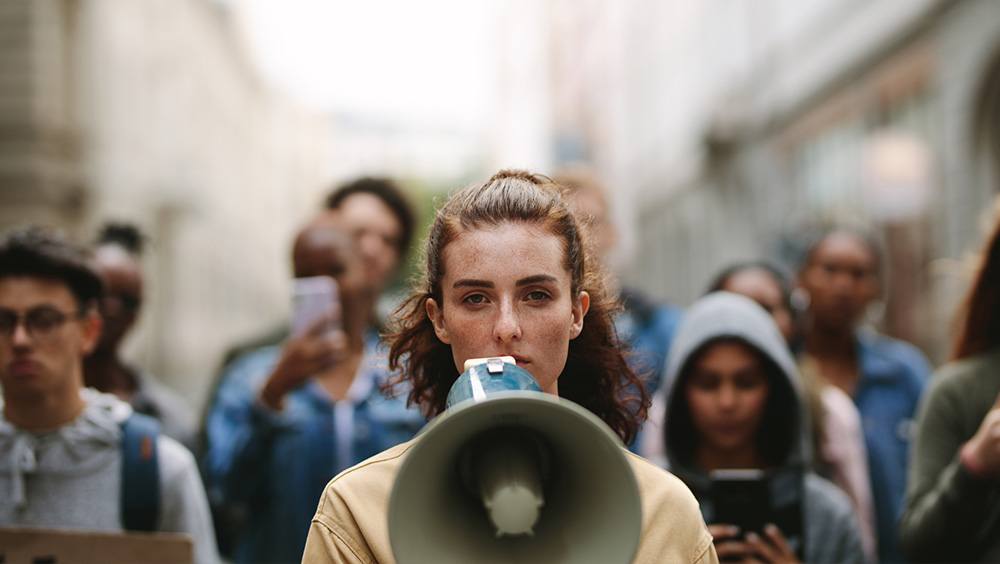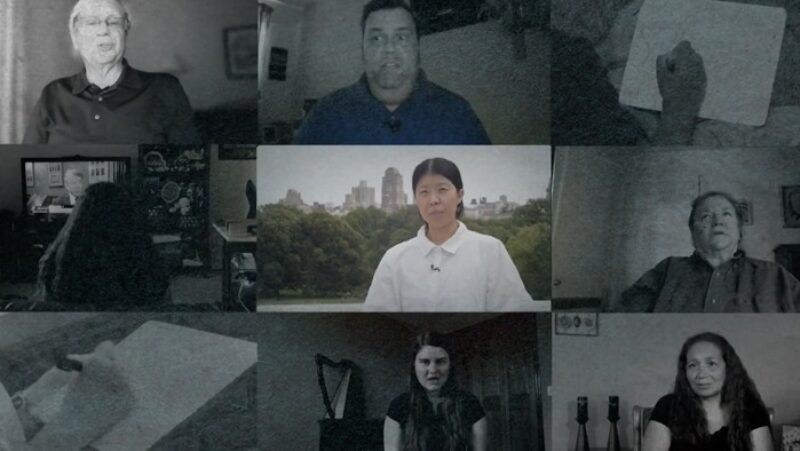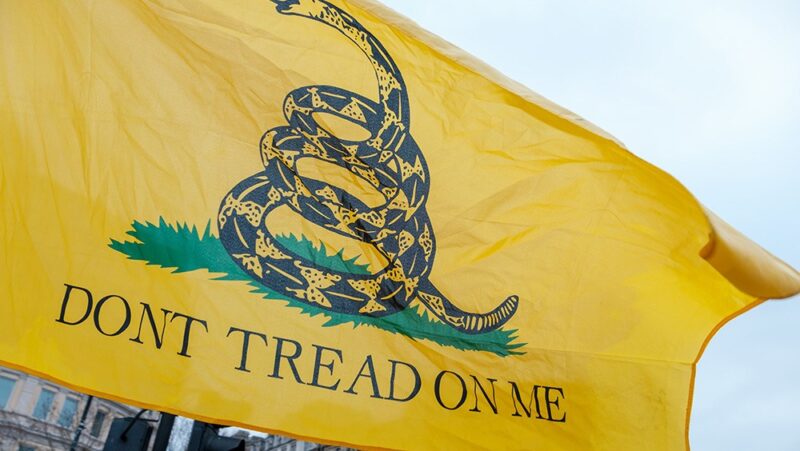10 Freedom of Speech Examples You Need to Know

The First Amendment protects freedom of speech, which means the government can’t prevent people from speaking or punish them for what they say, nor can the government force people to speak if they don’t want to.
But “speech” and the freedom to do it goes beyond the literal act of speaking words out loud. In the U.S., free speech under the First Amendment is broadly applied to many aspects of expression, including writing and listening to music, wearing your preferred clothes in public, performing and viewing a dance recital, writing and reading a book, making and watching movies, creating and appreciating art, donating to a candidate for office, or putting a sign with profanity in your yard.
However, like other First Amendment freedoms, there are legal limits to speech.
The First Amendment detailing the five freedoms it ensures has only 45 words, and what exactly qualifies as free speech is not spelled out word-for-word. Rather, since the First Amendment was added to the Constitution in 1791, the U.S. Supreme Court and lower courts have defined free speech and its exceptions through numerous cases. That's where these freedom of speech examples come in.
Freedom of speech does not cover all forms of speech, including some examples like defamation and libel, making threats, plagiarism, copyright infringement, and obscenity.
In this post we highlight freedom of speech examples based on what courts have ruled over the years.
Discover 10 freedom of speech examples from throughout U.S. history
1. Flag burning and desecration
The act of burning or destroying an American flag is controversial. But it's also a freedom of speech example.
Multiple members of Congress have tried unsuccessfully to pass constitutional amendments to make it illegal. Currently, burning or destroying a flag, sometimes called flag desecration, is speech protected under the First Amendment. The U.S. Supreme Court addressed the topic in a 1989 case (Texas v. Johnson). The court ruled in favor of Gregory Lee Johnson, who had been convicted under a Texas law that outlawed flag desecration. Johnson poured kerosene on a flag and set it on fire while protesting at the 1984 Republican National Convention in Dallas. In deciding the case and overturning the state law, the court said the act of burning a flag, while provocative and possibly offensive, is protected expression that counts as free speech under the First Amendment. The next year, the Supreme Court reaffirmed this idea in striking down a federal law prohibiting flag desecration in United States v. Eichman.
2. Political speech
True threats are not protected by the First Amendment because they can cause someone to fear for their life. But what exactly qualifies as a true threat, as opposed to saying something mean or something that is interpreted as threatening when it really is not, is not so clear cut. The Supreme Court has said a reasonable person must think the threat is actionable and fear for their safety and that the speaker must understand or recklessly disregard that what they are saying is a threat. When it comes to speaking about a political figure, the bar for what qualifies as an actual threat is high.
It is illegal to threaten the president, vice president and certain high-ranking officials. However, political speech, even words that are aggressive or perceived as hateful, is largely protected speech. The Supreme Court ruled on this in 1969 (Watts v. United States). Robert Watts was charged with threatening President Lyndon B. Johnson for saying at an anti-war rally that "if they ever make me carry a rifle, the first man I want to get in my sights is LBJ." The court ruled that Watts "had engaged in a crude form of political hyperbole." The court said his statements came during a political rally, and people who heard his remarks laughed. In other words: It was not a true threat but was protected political speech.
3. Prayer in school
The First Amendment’s establishment clause prevents the government, including public schools, from imposing any religious belief or favoring one religion over another. Public school students may use their First Amendment freedoms of religion and speech to practice their religion in school, including through prayer. In practice this means students may pray by themselves or in groups and meet to talk about matters of faith, including in extracurricular clubs held on campus.
However, schools may restrict prayer (and other activities such as protesting) if it interferes with the learning environment. Public school teachers and staff can also pray and practice their religious beliefs while at school as long as they don’t require or pressure students to join.
Multiple Supreme Court cases have led to this landscape of free speech and religious rights for being able to pray or not be forced to in public schools. In 1962, the court said a New York law requiring a prayer at the beginning of the school day violated the First Amendment. Other Supreme Court decisions in 1992 (Lee v. Weisman) and 2000 (Santa Fe Independent School District v. Doe) meant public schools could not require prayer at high school graduation or a student-led prayer over the loudspeaker at football games.
Prayer at high school football games is not totally out of bounds. In 2022, the court ruled (Kennedy v. Bremerton School District) in favor of a Washington state football coach who had been fired after refusing to stop praying on the field after games. The court said the coach had a First Amendment right to exercise his religious and speech rights through the prayer so long as students were not pressured or required to join.
4. Saying (or not saying) the Pledge of Allegiance
Saying what you want without being punished is considered free speech. Remaining silent can also be a freedom of speech example. While many schools begin their days by reciting the Pledge of Allegiance in classrooms (sometimes over the public address system), public school students cannot be required to say it.
The reason stems from two cases involving Pennsylvania and West Virginia students who were Jehovah’s Witnesses. The students felt swearing an allegiance to a government violated their religious faith, and they were expelled for refusing to say the pledge. In 1940, the Supreme Court ruled (Minersville School District v. Gobitis) that a Pennsylvania law requiring students to stand and recite the pledge did not violate the First Amendment. Three years later, the court considered another case from West Virginia students claiming the same thing as the Pennsylvania case. The students had refused to say the pledge and were threatened with reform school. In 1943 (West Virginia State Board of Education v. Barnette), the court reversed its previous ruling and said students have a free speech and religious freedom right not to stand or recite the pledge.
@1stforall Are students allowed to refuse to participate in the Pledge of Allegiance? 🇺🇸 #FirstAmendment #FreeSpeech #FYP #ForYou #ForYou #ForYourPage #America #America #American #AmericanFlag #TikTok #students #school
♬ original sound - Freedom Forum
5. Speech and protest in public schools
Unlike the right to vote, the right to free speech and other First Amendment freedoms doesn’t begin at 18. Students under age 18 in public schools still have free speech rights, though that right is not unlimited. Public school administrators can set limits on students’ speech and expression (including what they wear) if such limits are in place to make sure the learning environment is not disrupted.
The case that set the standard for public school students and freedom of speech came in 1969 (Tinker v. Des Moines Independent Community School District). Three students, Mary Beth Tinker, 13, John Tinker, 15, and Christopher Eckhardt, 16, were punished by their school for wearing black armbands, a type of speech meant to protest the Vietnam War. The Supreme Court ruled that public school students have their right to free speech, so administrators can’t censor speech just because they think something could be disruptive. Rather, the school must prove the speech has or will substantially disrupt the learning process, which is a higher bar to clear.
6. Political signs
Every election season brings a common sighting: the political sign, which advocates for or against certain candidates or causes. The Supreme Court identifies these types of signs as the most important type of speech to protect. Regulating political signs and other political speech must only be done without regard for the message itself and instead be done for a non-speech reason, such as to protect public safety by keeping signs of all kinds (political or otherwise) from cluttering state highways. Even these “content-neutral” restrictions on speech must be enforced equally across all viewpoints.
Electioneering is a term to describe several kinds of advocacy and campaigning, like holding political signs, handing out brochures, wearing candidate-specific clothing, asking people to sign petitions, or trying to persuade someone to vote a certain way. All states and the District of Columbia regulate electioneering at voting sites, though not all the same way. This list shows all the electioneering regulations for all states and Washington, D.C. Generally, electioneering restrictions are only upheld if they are narrowly written (for instance, there can be no campaigning within 100 feet of the ballot box on election day).
7. What you wear
This freedom of speech example has nothing to do with spoken word. What you wear is an example of free expression, which is protected speech under the First Amendment. Public schools have more leeway to restrict clothing or impose dress codes in order to preserve the learning environment.
Multiple state legislatures have tried to restrict drag performances, particularly for drag shows and drag story hours at libraries and where children might attend. In 2023, a federal judge struck down a Tennessee law that restricted drag performances, calling it “unconstitutionally vague and substantially overbroad.” The judge said that while obscenity is not protected by the First Amendment, there is a difference between the legal definition of obscenity and what people merely think is obscene. Also in 2023, a different federal judge struck down a similar Texas law on First Amendment grounds.
@1stforall Are drag performances protected by the First Amendment? #Drag #DragQueen #FirstAmendment #FreeExpression #FYP #ForYouPage
♬ original sound - Freedom Forum
8. Art
Many people create and appreciate art. They also spend plenty of time considering what, exactly, constitutes art. Whether painting oil on canvas, sculpting marble or putting objects in a jar, all can fall under the term art. And all can be protected speech under the First Amendment. The Supreme Court has broadly defined “art” and generally avoids imposing its own views on what is and is not art based on its own judgments as to quality, beauty, value, etc.
As with other forms of speech and expression, there are some narrow ways government can censor art under the First Amendment. For example, a public street art performance that uses full nudity and sex acts could be censored because narrowly drafted public nudity laws have been upheld even against First Amendment challenges.
One example of free speech colliding with attempts at government censorship came in 1999 in New York City. As a practicing Catholic and the city’s mayor, Rudy Giuliani didn’t like the publicly funded Brooklyn Museum displaying artist Chris Ofili's painting "The Holy Virgin Mary." The piece used elephant dung and bare butts cut from magazines. Giuliani said it was "sick" and thought it was sacrilegious. He threatened to cancel a larger exhibition at the museum if Ofili’s work wasn't removed. Giuliani cut off the museum's budget and said he'd make it vacate the building. The museum sued. A federal judge said the mayor violated the First Amendment. Ofili, who is Black and Catholic, called his painting "a hip-hop version" of the Virgin Mary. His work returned to the city in 2018 after being donated to the Museum of Modern Art.
9. Writing and reading books
Like art, books come in many styles, sizes and preferences. They also are broadly protected by the First Amendment, meaning the government cannot prevent books from being published and can’t stop people from buying or reading them except in very limited cases. However, standards of obscenity still apply for how and where they are distributed and displayed. Public schools and libraries also may restrict books for educational appropriateness. Parents also have a First Amendment right to petition school boards and public library boards to remove books from curriculum or put them in adults-only sections. That’s one reason the topic of book bans and other censorship attempts is in the news so much.
Today it is uncommon for a book to be stopped from being published – a restrictive government act known as “prior restraint” that often violates the First Amendment. However, it wasn’t uncommon in the not-too-distant past. Some books on modern lists of classic literature in the U.S. had a difficult time being printed, distributed and displayed in libraries due to attempts to ban them as obscene. These include works like “Ulysses” by James Joyce (1922), “Tropic of Cancer” by Henry Miller (1934), “The Catcher in the Rye” by J.D. Salinger (1951), and “Naked Lunch” by William S. Burroughs (1959).
Burroughs’ book and the many attempts to ban it helped set the stage for books that government officials tried to block from being published and distributed because they were considered obscene. In 1964, the Supreme Court ruled (Grove Press v. Gerstein) that books, like movies, can’t be considered obscene merely because they have sexual material. The standard for obscenity was higher, and obscene material had to be “utterly without redeeming social value.” By that standard, most books and movies were not considered legally obscene but rather were examples of free speech protected by the First Amendment.
10. Political donations
Of all the freedom of speech examples on this list, this one may be the most misunderstood.
It’s said that “money talks” about how currency influences, well, everything, but it can also apply to how it’s perceived as a form of speech in politics. Individuals have a right to donate money to their preferred candidates and causes, but what about corporations, unions and nonprofit organizations? When it comes to campaign donations, do these nonhuman entities have the right to use their money as a form of free speech just as individual people do?
The Supreme Court addressed that in a much-watched 2010 ruling (Citizens United v. Federal Election Commission). The court ruled that political spending by corporations and other groups is a form of speech protected by the First Amendment. According to the court, groups don’t have power to spend as much as they want directly supporting candidates, but they can spend unlimited amounts on ads and other forms of direct-to-voters media such as paid-for documentaries, billboards and books.
At the center of a case was a political action group named Citizens United, which had produced documentaries opposing Democrats John Kerry and Hillary Clinton for president in 2004 and 2008, respectively. The Federal Elections Commission limited distribution of the Clinton film, saying it violated campaign finance law passed by Congress in 2002. In ruling for Citizens United, the court said efforts to limit political spending by corporations and other groups violated their First Amendment right to free speech.
The bottom line on freedom of speech examples and current challenges
Since the First Amendment was added to the Constitution as part of the Bill of Rights in 1791, there have been freedom of speech examples stemming from how government tried to enforce restrictions, censor speech and use obscenity laws to keep people from speaking. The First Amendment doesn’t say anything about art, books, clothing or political spending, but they are all examples of how speech is defined and protected.
The U.S. no longer sees the kinds of broad restrictions on speech that resulted in comedians being arrested on stage, theater owners being prosecuted for showing movies with sex scenes, or publishers stopped from printing books. But there are still many questions about how far the First Amendment goes in protecting speech in all its forms.
Do protesters have a right to say anything they want when advocating for their cause or are there limits when people feel threatened or offended? If parents don’t like books found in school libraries or curriculum, how far can the government go in removing them? Are there ways that drag shows and other forms of gender-based expressive performances can be limited that don’t violate the First Amendment
These and other free speech examples frame the modern debate over how the First Amendment ensures everyone can use their right to freedom of speech and exactly what limits the government may impose that are not neatly spelled out in those 45 words.
Scott A. Leadingham is a Freedom Forum staff writer. Email
For These 5 Americans, the First Amendment Is an Everyday Essential
Dissent Is More Than Patriotic. It’s Baked Into the First Amendment
Related Content

